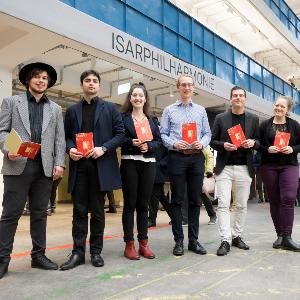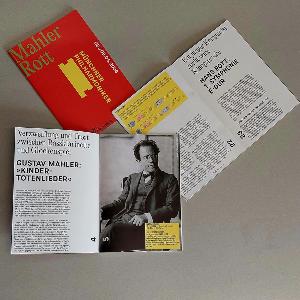From the lecture hall to the concert hall
22 May 2024
For a project seminar, musicology students design a concert booklet for the Munich Philharmonic.
22 May 2024
For a project seminar, musicology students design a concert booklet for the Munich Philharmonic.

The musicology students with the program they designed in front of the Isarphilharmonie. | © Tobias Hase
Shortly before going on stage, Nikolaos Therimiotis has butterflies in his stomach. The rehearsal room at the Isarphilharmonie concert hall is full to capacity. Music-lovers have come to listen to the concert introduction that LMU students deliver once a year. Happily, Therimiotis pulls off his performance with aplomb. The LMU musicology student talks about Gustav Mahler’s Kindertotenlieder song cycle on texts by the poet Friedrich Rückert and gives the audience a vivid impression of the deliberate stylistic countercurrents between musical and linguistic motifs in Mahler’s work.
When Therimiotis is finished, his fellow student Pia von dem Borne speaks about Hans Rott, who died young and was discovered late by conductors. She discusses the influences of various contemporaries who were important for Rott’s work and whose musical ideas he influenced in turn – including Gustav Mahler. Musical accompaniment is provided by Benjamin Röder, also a musicology student, who plays passages from the programmed pieces to give the audience a tangible experience of the stylistic features that his fellow students have elucidated. The concert introduction is such a hit with the listeners that a lively discussion ensues.
Later this evening and on the next, the Munich Philharmonic are playing Mahler’s Kindertotenlieder and Rott’s Symphony No. 1 in E major. And those who miss the concert introduction can still pick up scholarly yet entertaining texts about the programmed pieces and their composers when they arrive at the concert hall. As part of a collaboration between the Munich Philharmonic and the Institute of Musicology at LMU, five students have designed the concert booklet to be sold at the Isarphilharmonie on the evenings of the concert and published online. In a seminar with degree program coordinator Jan Golch, they collectively developed the concept for the booklet, defined the themes, and wrote the texts.
We publish around 30 concert booklets a year, and this one booklet designed by the students has a special status, including among management. Everybody looks forward to the student booklet – we’re always excited to see what it will look like this time. The students bring a fresh perspective, not least for the concert audiences.Christine Möller , Munich Philharmonic

The concert booklet | © LMU/Institut für Musikwissenschaft
The seminar is being run for the sixth year in succession. “Over the years, it has become a real institution,” says Jan Golch, who supervises the project together with two colleagues from the Munich Philharmonic: Christine Möller from the concert program editorial team and Rebecca Friedman from the Spielfeld Klassik outreach program. “We publish around 30 concert booklets a year, and this one booklet designed by the students has a special status, including among management. Everybody looks forward to the student booklet – we’re always excited to see what it will look like this time,” recounts Möller. “The students bring a fresh perspective, not least for the concert audiences.”
At the beginning of the seminar, they analyze existing concert booklets in a group and discuss what qualities they themselves expect a successful text to have. As a warm-up exercise, the students write texts about other pieces of music, which are then discussed by the group. Next, they develop a basic concept for the concert booklet, decide on a narrative structure, divide up themes and research tasks, and then get down to the actual writing. After an initial submission, the texts are discussed in detail at an editorial meeting, then revised and submitted again, before being sent out to the graphic designers and the printers.
You need to develop an eye for a specific angle – How can you, as an aspiring musicologist, deploy your analytical skills and convey what is special about a piece, a composer, a conductor, or a soloist in compelling prose?Jan Golch, LMU, program coordinator
“The concert booklet has added value for concertgoers when it informs and entertains,” explains seminar leader Golch. “It’d be a pity to have stuff in there which people can google or read in a concert guide. You need to develop an eye for a specific angle – How can you, as an aspiring musicologist, deploy your analytical skills and convey what is special about a piece, a composer, a conductor, or a soloist in compelling prose?”
Christine Möller from the concert program editorial team is enthusiastic about the creative approaches the students keep coming up with every year. “They have a free hand and indeed are supposed to develop their own style,” she says. From a fictional argument between Cosima and Richard Wagner to a scene that could come from the pages of a novel, in which Parisian musicians sit around in a salon – time after time, the students produce unusual perspectives and approaches which make the booklet special.
The seminar is very popular among students, with the number of participants deliberately limited to five. “I heard from somebody who did it last year how enjoyable it was, so I was looking forward to taking part this year,” says Raphael Landstorfer, who contributed a text on Hans Rott and his “fate symphony.” The seminar workload is intense for everyone involved: “You only get a pass when it has been printed. Until then, you work – to professional standards. This includes keeping deadlines and being able to take constructive criticism,” says Golch.
There was an amazing atmosphere in the hall. For us seminar participants, the evening was special anyway. But it was also an event the audience are sure to fondly remember.Felicitas Strobl, student
The students have the opportunity not only to present their texts in the public sphere in the program booklet and at the concert introduction, but also to gain exclusive insights into the operations of the Munich Philharmonic. For example, they get to sit in on a rehearsal, have talks with members of the management board and the artistic manager’s office, and attend a meet-and-greet with the conductor and the soloist. “In this way, they familiarize themselves with the daily work surrounding the orchestra,” explains Rebecca Friedman from Spielfeld Klassik.
There was a particular highlight last year, when the soloist Patricia Kopatchinskaja asked the students about a brief song quotation from the first violin concerto of Béla Bartók, the origin of which she was curious about. The students found various conjectures in the literature, carried out research with the aid of the Bartók Archives in Budapest, and finally discovered that Bartók had quoted in his piece a German round by Hans von Koessler on a text by Wilhelm Busch.
On the evening of the concert, the violinist Kopatchinskaja – to the surprise of the students – turned to the audience, told them about the research, and played an encore, for which the orchestra joined in and the audience sang in four-part canon. “There was an amazing atmosphere in the hall,” recalls Felicitas Strobl, who wrote about Bartók’s violin concerto for the concert booklet. “For us seminar participants, the evening was special anyway. But it was also an event the audience are sure to fondly remember.” This is a prime example of how beneficial the collaboration is for both sides – from the concert hall to the lecture hall and back again.
Concert booklet: pdf
LMU cultural partnerships